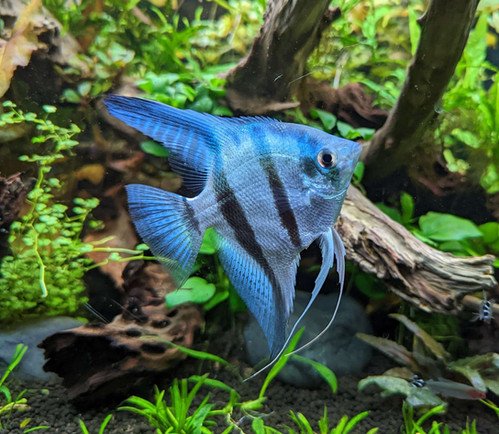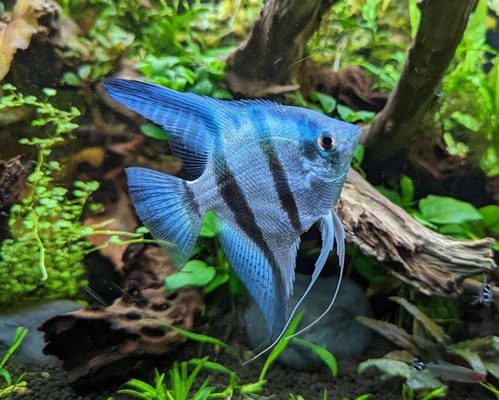
Imagine sitting in a cozy café, sipping your favorite drink, and chatting about these elegant fish. You might find yourself wondering what their playful antics mean or why they sometimes seem a bit standoffish. Well, I’m here to break it down for you! We’ll explore the ins and outs of angelfish behavior, helping you become a pro at reading your finned friends and creating the best environment for them.
Understanding Angelfish Behavior
Angelfish, or *Pterophyllum scalare*, are known for their unique personalities and social structures. They’re not just colorful decorations in your tank; they have a complex range of emotions and behaviors. So, while you might think you just need to feed them and keep the water clean, there’s so much more to their world.
Here’s the thing: angelfish can communicate through their actions. From swimming patterns to how they interact with tank mates, each behavior can tell you something important. For instance, if your angelfish is consistently hiding, it might be feeling stressed. On the flip side, if it’s swimming freely and exploring, that’s a sign of a happy, healthy fish.
Understanding these behaviors is crucial not only for the well-being of your angelfish but also for you as an aquarist. It helps you create a supportive environment where your fish can thrive.
Common Angelfish Behaviors
Let’s dig into some of the most common behaviors you might see in angelfish. Just like we all have our quirks, each angelfish has its way of expressing itself. Here are some typical behaviors and what they generally mean:
- Swimming Patterns: If your angelfish swims near the top of the tank, it’s typically looking for food or enjoying the space. However, erratic swimming can signal stress or illness.
- Hiding: When angelfish hide, it might be due to a range of factors, from feeling threatened by tank mates to discomfort with water parameters.
- Aggressive Behavior: If two angelfish are flaring their fins and chasing one another, it could be a territorial dispute. This is common during mating or when introducing new fish.
Understanding these signs is important. If you notice changes in behavior, it might be time to check on their environment or health.
Social Interaction with Other Fish
Angelfish are considered semi-aggressive, which means they can be quite sociable but also possessive of their space. When adding new fish to your tank, it’s essential to observe how they interact. You might be wondering, “Can I keep angelfish with other types of fish?”
The answer is yes, but caution is necessary. Good tank mates for angelfish include:
- Discus fish
- Guppies
- Neon tetras
On the other hand, you should avoid keeping them with small fish, as angelfish may see them as snacks, or overly aggressive species that could bully your angelfish.
Watching how your angelfish interacts can be like going to a dinner party—you’ll want to ensure everyone is getting along. If you see constant bullying or hiding, it might be time to rearrange your tank or consider new companions.
Why Angelfish Change Color
Have you noticed your angelfish occasionally changing color? This is a fascinating aspect of their behavior! Angelfish can darken or lighten depending on various factors such as stress, mood, or even the time of day.
For instance, when they feel threatened, they might darken to blend in better with their surroundings. On the contrary, a happy angelfish will display its brightest colors. This ability to change color is similar to how we might change our expression depending on our feelings—happy or sad, present or withdrawn.
It’s essential to monitor these color changes. If your angelfish is frequently darkening, it’s worth investigating potential stressors in the tank, such as aggressive tank mates or poor water quality.
Feeding Habits and Their Importance
Feeding angelfish isn’t just about dropping flakes into the tank. Their feeding habits can reveal a lot about their overall health and happiness. For instance, if your angelfish eagerly hits the surface when food is introduced, that’s a positive sign of good health.
However, if they ignore the food or nibble half-heartedly, it could mean something’s off. They might be stressed, sick, or not getting the right type of food.
Here are some tips to keep those fins swimming happily:
- Offer a varied diet, including flakes, pellets, and occasional live or frozen food.
- Feed small amounts several times a day instead of one large feeding.
- Keep an eye on how much food is left after feeding to avoid overfeeding.
Feeding is not just a necessity—it’s a way to bond with your fish and ensure they’re thriving in their environment.
Signs of Stress in Angelfish
Stress can be a major issue for angelfish and can lead to health problems if not addressed. Common signs of stress include:
- Hiding more than usual
- Flicking against objects in the tank
- Loss of appetite
If you notice any of these signs, it’s essential to take action. Start by checking the water quality—ammonia, nitrite, and pH levels can greatly impact their well-being. Also, evaluate their tank mates. Remember, just like us, angelfish have their comfort zones, and any disruption can lead to anxiety.
Addressing stress promptly can make a significant difference in your angelfish’s behavior and health.
Creating the Ideal Environment for Angelfish
Creating the right environment is key to keeping your angelfish happy and healthy. The more comfortable they feel, the more likely they are to display their natural behaviors. Here are some aspects to consider:
- Tank Size: Angelfish need space to swim and establish territories. A tank of at least 20 gallons is ideal for a pair.
- Water Conditions: Keep the temperature around 75–82°F (24–28°C) and ensure good filtration to maintain water quality.
- Decor and Hiding Spots: Provide plants, rocks, and other decorations. This not only helps them feel secure but also mimics their natural habitat.
When you set up a cozy and welcoming space, you’re likely to see your angelfish flourish. Just think of it as designing a nice home—they’ll be more comfortable and less stressed.
Wrapping It Up
The behavior of angelfish is like reading a fascinating book filled with twists and turns. Understanding their actions—whether it’s their swimming patterns, social interactions, or feeding habits—can enhance your relationship with these beautiful creatures. When you know what to look for, you can create the best environment to help them thrive.
Whether you’re a first-time angelfish owner or a seasoned aquarist, paying attention to these behaviors will make your experience much more rewarding. By fostering a happy and healthy environment, you’re contributing to their story and ensuring they continue to dazzle you with their beauty and charm. So, grab a cup of coffee, sit back, and enjoy the wonderful world of your angelfish!

